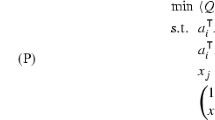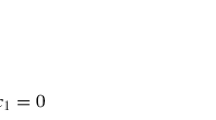Abstract
Yuan’s theorem of the alternative is an important theoretical tool in optimization, which provides a checkable certificate for the infeasibility of a strict inequality system involving two homogeneous quadratic functions. In this paper, we provide a tractable extension of Yuan’s theorem of the alternative to the symmetric tensor setting. As an application, we establish that the optimal value of a class of nonconvex polynomial optimization problems with suitable sign structure (or more explicitly, with essentially nonpositive coefficients) can be computed by a related convex conic programming problem, and the optimal solution of these nonconvex polynomial optimization problems can be recovered from the corresponding solution of the convex conic programming problem. Moreover, we obtain that this class of nonconvex polynomial optimization problems enjoy exact sum-of-squares relaxation, and so, can be solved via a single semidefinite programming problem.
Similar content being viewed by others
References
Yuan, Y.X.: On a subproblem of trust region algorithms for constrained optimization. Math. Prog. 47, 53–63 (1990)
Yan, Z.Z., Guo, J.H.: Some equivalent results with Yakubovich’s S-lemma. SIAM J. Control Optim. 48(7), 4474–4480 (2010)
Jeyakumar, V., Huy, H.Q., Li, G.: Necessary and sufficient conditions for S-lemma and nonconvex quadratic optimization. Optim. Eng. 10, 491–503 (2009)
Pólik, I., Terlaky, T.: A survey of the S-Lemma. SIAM Rev. 49, 371–418 (2007)
Sturm, J.F., Zhang, S.Z.: On cones of non-negative quadratic functions. Math. Oper. Res. 28, 246–267 (2003)
Yakubovich, V.A.: S-Procedure in nonlinear control theory. Vestnik Leningrad. Univ. 1, 62–77 (1971)
Chen, X., Yuan, Y.: A note on quadratic forms. Math. Program. 86, 187–197 (1999)
Polyak, B.T.: Convexity of quadratic transformation and its use in control and optimization. J. Optim. Theory Appl. 99, 563–583 (1998)
Crouzeix, J.P., Martinez-Legaz, J.E., Seeger, A.: An theorem of the alternative for quadratic forms and extensions. Linear Algebr. Appl. 215, 121–134 (1995)
Martínez-Legaz, J.E., Seeger, A.: Yuan’s theorem of the alternative and the maximization of the minimum eigenvalue function. J. Optim. Theory Appl. 82(1), 159–167 (1994)
Jeyakumar, V., Lee, G.M., Li, G.: Alternative theorems for quadratic inequality systems and global quadratic optimization. SIAM J. Optim. 20(2), 983–1001 (2009)
Lim, L.H.: Singular values and eigenvalues of tensors, A variational approach, In: Proceedings of the 1st IEEE International workshop on computational advances of multi-tensor adaptive processing, pp. 129–132, (2005)
Qi, L.: Eigenvalues of a real symmetric tensor. J. Symb. Comput. 40, 1302–1324 (2005)
Bomze, I.M., Ling, C., Qi, L., Zhang, X.: Standard bi-quadratic optimization problems and unconstrained polynomial reformulations. J. Glob. Optim. 52, 663–687 (2012)
He, S., Li, Z., Zhang, S.: Approximation algorithms for homogeneous polynomial optimization with quadratic constraints. Math. Program. 125, 325–383 (2010)
Zhang, X., Qi, L., Ye, Y.: The cubic spherical optimization problems. Math. Comput. 81, 1513–1525 (2012)
Ling, C., Nie, J., Qi, L., Ye, Y.: Bi-quadratic optimization over unit spheres and semidefinite programming relaxations. SIAM J. Optim. 20, 1286–1310 (2009)
So, A.M.-C.: Deterministic approximation algorithms for sphere constrained homogeneous polynomial optimization problems. Math. Program. 129, 357–382 (2011)
Li, G., Mordukhovich, B.S., Pham, T.S.: New fractional error bounds for polynomial systems with applications to Hölderian stability in optimization and spectral theory of tensors, to appear in Math. Program. doi:10.1007/s10107-014-0806-9
Qi, L., Xu, Y., Yuan, Y., Zhang, X.: A cone constrained convex program: structure and algorithms. J. Oper. Res. Soc. China 1, 37–53 (2013)
Qi L., Ye, Y.: Space tensor conic programming. Comp. Optim. Appl. 59, 307–319 (2014)
Cooper, J., Dutle, A.: Spectral of hypergraphs. Linear Algebr. Appl. 436, 3268–3292 (2012)
Hu, S., Qi, L.: Algebraic connectivity of an even uniform hypergraph. J. Comb. Optim. 24, 564–579 (2012)
Li, G., Qi, L., Yu, G.: The Z-eigenvalues of a symmetric tensor and its application to spectral hypergraph theory. Num. Linear Algebr. Appl. 20(6), 1001–1029 (2013)
Qi, L.: H\(^+\)-eigenvalues of Laplacian and signless Laplacian tensors. Commun. Math. Sci. 12, 1045–1064 (2014)
Ng, M., Qi, L., Zhou, G.: Finding the largest eigenvalue of a non-negative tensor. SIAM J. Matrix Anal. Appl. 31, 1090–1099 (2009)
Lathauwer, L. De, Moor, B.: From matrix to tensor: Multilinear algebra and signal processing. In: J. McWhirter, Editor, Mathematics in Signal Processing IV, Selected papers presented at 4th IMA International Conference on Mathematics in Signal Processing, Oxford University Press, Oxford, United Kingdom, pp. 1–15, (1998)
Qi, L., Teo, K.L.: Multivariate polynomial minimization and its application in signal processing. J. Global Optim. 46, 419–433 (2003)
Qi, L., Yu, G., Wu, E.X.: Higher order positive semi-definite diffusion tensor imaging. SIAM J. Imaging Sci. 3, 416–433 (2010)
Chang, K.C., Pearson, K., Zhang, T.: Primitivity, the convergence of the NZQ method, and the largest eigenvalue for non-negative tensors. SIAM J. Matrix Anal. Appl. 32, 806–819 (2011)
Hu, S., Li, G., Qi, L., Song, Y.: Finding the maximum eigenvalue of essentially non-negative symmetric tensors via sum of squares programming. J. Optim. Theory Appl. 158(3), 713–738 (2013)
Kofidis, E., Regalia, Ph: On the best rank-1 approximation of higher-order symmetric tensors. SIAM J. Matrix Anal. Appl. 23, 863–884 (2002)
Kolda, T.G., Bader, B.W.: Tensor decompositions and applications. SIAM Rev. 51(3), 455–500 (2009)
Li, G., Qi, L., Yu, G.: Semismoothness of the maximum eigenvalue function of a symmetric tensor and its application. Linear Algebr. Appl. 438, 813–833 (2013)
Liu, Y., Zhou, G., Ibrahim, N.F.: An always convergent algorithm for the largest eigenvalue of an irreducible non-negative tensor. J. Comput. Appl. Math. 235(1), 286–292 (2010)
Zhang, L., Qi, L., Luo, Z., Xu, Y.: The dominant eigenvalue of an essentially non-negative tensor. Num. Linear Algebr. Appl. 20(6), 929–941 (2013)
Yang, Y.N., Yang, Q.Z.: Further results for Perron–Frobenius theorem for non-negative tensors. SIAM J. Matrix Anal. Appl. 31(5), 2517–2530 (2010)
Lasserre, J.B.: Moments. Positive Polynomials and their Applications. Imperial College Press, London (2009)
Laurent, M.: Sums of squares, moment matrices and optimization over polynomials. Emerging Applications of Algebraic Geometry, Vol. 149 of IMA Volumes in Mathematics and its Applications, M. Putinar and S. Sullivant (eds.), Springer, Berlin pp. 157–270, (2009)
Parrilo, P.A.: Semidefinite programming relaxations for semialgebraic problems. Math. Program. Ser. B 96(2), 293–320 (2003)
Hilbert, D.: Über die Darstellung definiter Formen als Summe von Formenquadraten. Math. Ann. 32, 342–350 (1888)
Reznick, B.: Some concrete aspects of Hilbert’s 17th Problem. Real algebraic geometry and ordered structures (Baton Rouge, LA, 1996), Contemporary mathematics 253, American Mathematical Society, Providence, pp. 251–272, (2000)
Reznick, B.: Sums of Even Powers of Real Linear Forms, Memoirs of the American Mathematical Society, Number 463, (1992)
Fidalgo, C., Kovacec, A.: Positive semidefinite diagonal minus tail forms are sums of squares. Math. Z. 269, 629–645 (2011)
Zalinescu, C.: Convex Analysis in General Vector Spaces. World Scientific, Singapore (2002)
Friedgut, E.: Hypergraphs, entropy, and inequalities. Am. Math. Mon. 111, 749–760 (2004)
Lasserre, J.B.: Global optimization with polynomials and the problem of moments. SIAM J. Optim. 11, 796–817 (2001)
Há, H.V., Pham, T.S.: Representations of positive polynomials and optimization on noncompact semialgebraic sets. SIAM J. Optim. 20(6), 3082–3103 (2010)
Nie, J., Demmel, J., Sturmfels, B.: Minimizing polynomials via sum of squares over the gradient ideal. Math. Program. Ser. A 106(3), 587–606 (2006)
Schweighofer, M.: Global optimization of polynomials using gradient tentacles and sums of squares. SIAM J. Optim. 17(3), 920–942 (2006)
Ghasemi, M., Lasserre, J. B., Marshall, M.: Lower Bounds on the Global Minimum of a Polynomial, arXiv:1209.3049.
Ghasemi, M., Marshall, M.: Lower bounds for polynomials using geometric programming. SIAM J. Optim. 22, 460–473 (2012)
Löfberg, J.: Pre- and post-processing sum-of-squares programs in practice. IEEE Trans. Autom. Control 54, 1007–1011 (2009)
Löfberg, J.: YALMIP: A Toolbox for Modeling and Optimization in MATLAB. In: Proceedings of the CACSD Conference, Taipei, (2004)
Papy, J.M., De Lathauwer, L., Van Huffel, S.: Exponential data fitting using multilinear algebra: The single-channel and multi-channel case. Num. Linear Algebr. Appl. 12, 809–826 (2005)
Ding, W., Qi L., Wei, Y.: Fast Hankel Tensor-vector Products and Application to Exponential Data Fitting, (2014). arXiv: 1401.6238
Chen Z., Qi, L.: Circulant Tensors with Applications to Spectral Hypergraph Theory and Stochastic Process, (2014). arXiv:1312.2752
Acknowledgments
The authors would like to express their sincere thanks to the referees for their constructive comments and valuable suggestions, which have contributed to the revision of this paper. Moreover, the second author would like to thank Prof. J. B. Lasserre and Prof. T. S. Pham for pointing out the related references [50, 51] during their visit in UNSW. Research was partially supported by the Australian Research Council Future Fellowship (FT130100038) and the Hong Kong Research Grant Council (Grant Nos. PolyU 502510, 502111, 501212, and 501913), and the National Natural Science Foundation of China (Grant No. 11401428 and 11101303).
Author information
Authors and Affiliations
Corresponding author
Appendix
Appendix
Proof of Proposition 2.1
Proof
As any SOS polynomial takes non-negative value, \(\mathrm{SOS}_{m,n} \cap E_{m,n} \subseteq \mathrm{PSD}_{m,n} \cap E_{m,n}\) always holds. We only need to show the converse inclusion. To establish this, let \(\mathcal {A} \in \mathrm{PSD}_{m,n} \cap E_{m,n}\), and let us consider the associated homogeneous polynomial:
Then, \(f\) is a polynomial which takes non-negative value. Note that
where \(I:=\{(i,i,\ldots ,i) \in \mathbb {N}^m: 1 \le i \le n\}.\) As \(\mathcal {A}\) is essentially nonpositive, \(\mathcal {A}_{i_1i_2\cdots i_m} \le 0\) for all \((i_1,\ldots ,i_m) \notin I\). Now, let \(f(x)=\sum _{i=1}^n f_{m,i} x_i^{m}+\sum _{\alpha \in \Omega _f}f_{\alpha }x^{\alpha }\). Then, \(f_{m,i}=\mathcal {A}_{ii\cdots i}\) and \(f_{\alpha } < 0\) for all \(\alpha \in \Omega _f\) where \(\Omega _f=\{\alpha =(\alpha _1,\ldots ,\alpha _n) \in (\mathbb {N}\cup \{0\})^n: f_{\alpha } \ne 0 \text { and } \alpha \ne m e_i, \ i=1,\ldots ,n\},\) and \(e_i\) is the vector where its \(i\)th component is one and all the other components are zero. Recall that \(\Delta _f = \{\alpha =(\alpha _1,\ldots ,\alpha _n) \in \Omega _f: f_{\alpha } < 0 \text { or } \alpha \notin (2\mathbb {N}\cup \{0\})^n\}.\) Note that \(f_{\alpha }<0\) for all \(\alpha \in \Omega _f\), and so, \(\Delta _f=\Omega _f\). It follows that
So, \(\hat{f}\) is also a polynomial which takes non-negative value. Thus, the conclusion follows by Lemma 2.1. \(\square \)
Rights and permissions
About this article
Cite this article
Hu, S., Li, G. & Qi, L. A Tensor Analogy of Yuan’s Theorem of the Alternative and Polynomial Optimization with Sign structure . J Optim Theory Appl 168, 446–474 (2016). https://doi.org/10.1007/s10957-014-0652-1
Received:
Accepted:
Published:
Issue Date:
DOI: https://doi.org/10.1007/s10957-014-0652-1
Keywords
- Alternative theorem
- Symmetric tensors
- Nonconvex polynomial optimization
- Sum-of-squares relaxation
- Semidefinite programming




